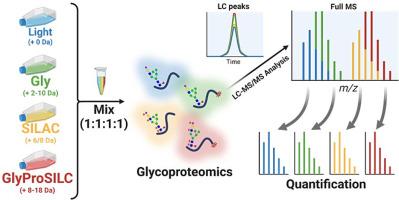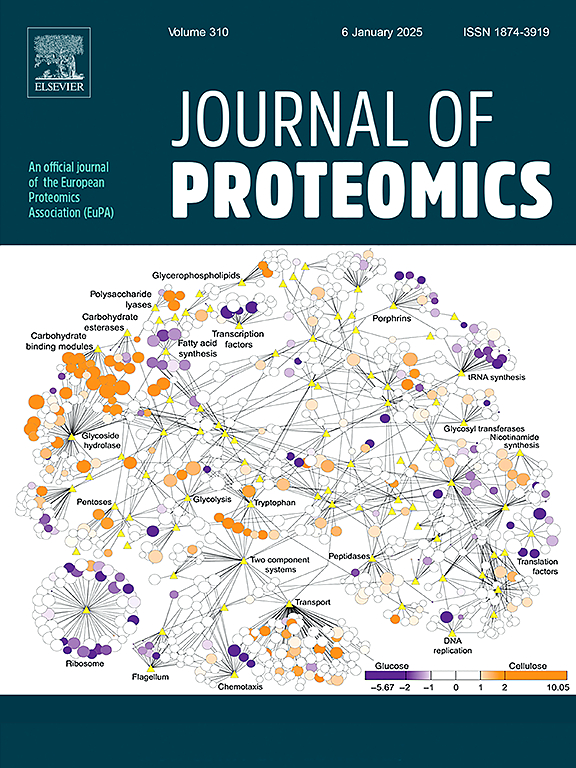利用细胞培养中的聚糖/蛋白质稳定同位素标记技术进行四重定量糖蛋白组学研究。
IF 2.8
2区 生物学
Q2 BIOCHEMICAL RESEARCH METHODS
引用次数: 0
摘要
糖蛋白丰度和聚糖结构的变化与多种疾病密切相关。糖蛋白组学的定量探索对于生物标记物的发现至关重要,但由于丰度低、复杂性高以及缺乏通用技术,对生物样本进行全面分析仍具有挑战性。我们利用 LC-ESI-MS 平台开发了一种多重糖蛋白组学方法,用于直接比较糖蛋白组学定量。在细胞培养过程中对糖肽进行同位素标记,实现了糖和肽的高标记效率(≥ 95 %)。将同一细胞系按 1:1:1:1 的比例混合后进行定量验证,并应用数学校正对比例进行解旋。该方法证明是可靠的,并被应用于三个乳腺癌细胞系(HTB22、MDA-MB-231、MDA-MB-231BR)和一个脑癌细胞系(CRL-1620)的糖蛋白组学比较研究,对三个重复的糖肽进行定量。对糖肽的表达进行了相对量化,并研究了细胞系之间的上调/下调情况。这种方法有助于深入了解糖基化微异质性,对乳腺癌脑转移研究至关重要。这种方法的优点包括消除了纳米电喷雾离子化产生的波动,缩短了分析时间,一次进样可完成多达 4 个复合物的分析。代谢标记引入了 MS1 级别的质量差异,确保提高灵敏度和分辨率,从而实现精确定量。意义:糖蛋白丰度的变化、糖基化水平的变化以及聚糖结构的变化与多种疾病密切相关。糖蛋白组学的定量探索已成为生物标记物发现的热门研究领域。然而,由于丰度低、固有的复杂性以及缺乏通用的定量技术,对生物样本中的糖蛋白组进行全面的定量分析仍然具有挑战性。在此,我们开发了一种使用 LC-ESI-MS 平台的多重糖蛋白组方法,以促进糖蛋白组定量的直接比较并提高通量。这种方法具有消除纳米电喷雾离子化(ESI)引起的定量波动和缩短分析时间等优点,一次进样可完成多达 4 个复合物的糖蛋白组分析。糖肽在细胞培养过程中进行了稳定的同位素标记,附着在单糖、氨基酸或两者上。我们实现了聚糖和肽的高标记效率(≥ 95 %)。我们以 1:1:1:1 的比例混合同一细胞系,对糖肽进行了定量验证。由于同位素重叠,采用数学校正法对 4 倍糖肽的比例进行了解旋。该方法证明了定量的可靠性,并成功地应用于三个乳腺癌细胞(HTB22、MDA-MB-231 和 MDA-MB-231BR)和一个脑癌细胞(CRL-1620)的糖蛋白组学比较研究,从三个重复品中鉴定出共计 264 个糖肽。对这四种细胞中糖肽的表达进行了相对量化,并对两种细胞系之间的上调/下调进行了研究。通过糖肽定量探索糖基化微异质性可能为进一步研究乳腺癌脑转移提供有价值的见解。结论我们所做工作的主要优势在于结合了 SILAC 和 IDAWG 这两种成熟的标记技术,从而实现了多重化,这两种技术在科学界都得到了有效的应用和广泛的引用。这种结合提高了我们方法的适用性和准确性,这一点从这两种技术的广泛引用和成功独立使用中可见一斑。我们相信,尽管该方法目前仅限于细胞系统,但这种多路复用方法将极大地推动该领域的发展。本文章由计算机程序翻译,如有差异,请以英文原文为准。

4-plex quantitative glycoproteomics using glycan/protein-stable isotope labeling in cell culture
Alterations in glycoprotein abundance and glycan structures are closely linked to numerous diseases. The quantitative exploration of glycoproteomics is pivotal for biomarker discovery, but comprehensive analysis within biological samples remains challenging due to low abundance, complexity, and lack of universal technology. We developed a multiplex glycoproteomic approach using an LC-ESI-MS platform for direct comparison of glycoproteomic quantitation. Glycopeptides were isotopically labeled during cell culture, achieving high labeling efficiency (≥ 95 %) for both glycans and peptides. Quantitation was validated by mixing the same cell line in a 1:1:1:1 ratio, with mathematical correction applied to deconvolute the ratios. This method proved reliable and was applied to a comparative glycoproteomic study of three breast cancer cell lines (HTB22, MDA-MB-231, MDA-MB-231BR) and one brain cancer cell line (CRL-1620), quantifying glycopeptides from three replicates. The expression of glycopeptides was relatively quantified, and up/down-regulation between cell lines was investigated. This approach provided insights into glycosylation microheterogeneity, crucial for breast cancer brain metastasis research. Benefits include eliminating fluctuations from nano electrospray ionization and reducing analysis time, enabling up to 4-plex profiling in a single injection. Metabolic labeling introduced mass differences at the MS1 level, ensuring increased sensitivity and higher resolution for accurate quantitation.
Significance
Alternations in glycoprotein abundance, changes in glycosylation levels, and variations in glycan structures are closely linked to numerous diseases. The quantitative exploration of glycoproteomics has emerged as a popular area of research for biomarker discovery. However, conducting a comprehensive quantitative analysis of the glycoproteome within biological samples remains challenging due to low abundance, inherent complexities, and the absence of universal quantitative technology. Here, we developed a multiplex glycoproteomic approach using an LC-ESI-MS platform to facilitate direct comparison of glycoproteomic quantitation and enhance throughput. This approach offers benefits such as eliminating quantitative fluctuations arising from nano electrospray ionization (ESI) and reducing analysis time, enabling up to 4-plex glycoproteomic profiling in a single injection. Glycopeptides were stable isotopic labeled during cell culture procedure, attaching to monosaccharides, amino acids, or both. We achieved a high labeling efficiency (≥ 95 %) for both glycans and peptides. Quantitation validation was tested on glycopeptides by mixing the same cell line with 1:1:1:1 ratio. Due to the overlapped isotopes, a mathematical correction was applied to deconvolute the ratio of 4-plex glycopeptides. This method demonstrated quantitative reliability and was successfully applied to a comparative glycoproteomic study of three breast cancer cells (HTB22, MDA-MB-231, and MDA-MB-231BR) and one brain cancer cell (CRL-1620), identifying a total of 264 glycopeptides from three replicates. The expression of glycopeptides among these four cells was relatively quantified and up/down-regulation between two cell lines was investigated. The exploration of glycosylation microheterogeneity through glycopeptide quantification may offer valuable insights for further investigation into breast cancer brain metastasis.
Conclusion: The primary advantage of our presented work lies in the multiplexing offered by combining two established labeling techniques, SILAC and IDAWG, both of which have been effectively used and widely cited in the scientific community. This combination enhances the applicability and accuracy of our method, as demonstrated by the extensive citations and successful use of these techniques independently. We believe that this multiplexing approach significantly advances the field, despite the method's current limitation to cell systems.
求助全文
通过发布文献求助,成功后即可免费获取论文全文。
去求助
来源期刊

Journal of proteomics
生物-生化研究方法
CiteScore
7.10
自引率
3.00%
发文量
227
审稿时长
73 days
期刊介绍:
Journal of Proteomics is aimed at protein scientists and analytical chemists in the field of proteomics, biomarker discovery, protein analytics, plant proteomics, microbial and animal proteomics, human studies, tissue imaging by mass spectrometry, non-conventional and non-model organism proteomics, and protein bioinformatics. The journal welcomes papers in new and upcoming areas such as metabolomics, genomics, systems biology, toxicogenomics, pharmacoproteomics.
Journal of Proteomics unifies both fundamental scientists and clinicians, and includes translational research. Suggestions for reviews, webinars and thematic issues are welcome.
 求助内容:
求助内容: 应助结果提醒方式:
应助结果提醒方式:


